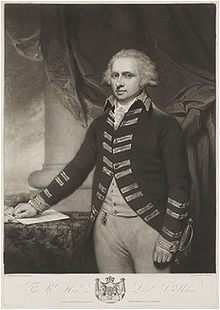Alleyne FitzHerbert, 1st Baron St Helens
PC | |
|---|---|
 | |
| Chief Secretary for Ireland | |
| In office 1787–1789 | |
| Preceded by | Thomas Orde-Powlett |
| Succeeded by | Robert Hobart |
| Personal details | |
| Born | 1 March 1753 Derby |
| Died | 19 February 1839 (aged 85)[1] Grafton Street, London |
| Parent(s) | William and Mary Fitzherbert[1] |
| Education | St John's College, Cambridge |
| Occupation | diplomat |
Alleyne FitzHerbert, 1st Baron St Helens,
He was a friend of explorer George Vancouver, who named Mount St. Helens in what is now the U.S. state of Washington after him.[3]
Life
Alleyne was fifth and youngest son of
Cambridge
In July 1770 he matriculated as pensioner at
Gray, attended by several of his friends, paid a visit to the young undergraduate in his college rooms, and as the poet rarely went outside his own college, his presence attracted great attention, and the details of the interview were afterwards communicated to Samuel Rogers, and printed by Mitford. Fitzherbert took his degree of B. A. in 1774, being second of the senior optimes in the mathematical tripos, and was also the senior chancellor's medallist.[4] Soon afterwards he went on a tour through France and Italy.
Diplomat
In February 1777 he began a long course of foreign life with the appointment of
Spain
When differences broke out between Great Britain and Spain respecting the right of British subjects to trade at

In the following year, Commander George Vancouver and the officers of HMS Discovery made the Europeans' first recorded sighting of Mount St. Helens on 19 May 1792, while surveying the northern Pacific Ocean coast. Vancouver named the mountain after the newly created Baron on 20 October 1792,[3] as it came into view when the Discovery passed into the mouth of the Columbia River.
A treaty of alliance between Great Britain and Spain was concluded by him in 1793, but as the climate of that country did not agree with his health he returned home early in 1794. Very shortly after his landing in England, St. Helens was appointed to the ambassadorship at the Hague (25 March 1794), where he remained until the French conquered the country, when the danger of his situation caused much anxiety to his friends.
A year or two later a great misfortune happened to him. On 16 July 1797 his house, containing everything he possessed, was burnt to the ground, and he himself narrowly escaped a premature death. He has lost, 'wrote Lord Minto, "every scrap of paper he ever had. Conceive how inconsolable that loss must be to one who has lived his life. All his books, many fine pictures, prints and drawings in great abundance, are all gone."[2]
Russia
His last foreign mission was to
Retirement
This completed his services abroad, and on 5 April 1803 he retired from diplomatic life with a pension of £2,300 a year. When Addington was forced to resign the premiership, St. Helens, who was much attached to George III, and was admitted to more intimate friendship with that king and his wife than any other of the courtiers, was created a lord of the bedchamber (May 1804), and the appointment is said to have been made against Pitt's wishes. He declared that he could not live out of London, and he therefore dwelt in Grafton Street all the year round. Although he repurchased Somersal Herbert Hall, an old family property, in 1806, he lent it for life to a cousin, the novelist Frances Jacson and her sister.[8] His consummate prudence and his quiet, polished manners are the theme of Nathaniel Wraxall's praise. Rogers and Jeremy Bentham were included in the list of his friends.[1]
To Rogers he presented in his last illness Pope's own copy of Garth's Dispensary, with Pope's manuscript annotations. Bentham had been presented to St. Helens by his elder brother, sometime member for
Personal life
St. Helens never married nor had children. However, he was known to have a very close relationship with Princess Elizabeth, third daughter of George III. Seventeen years older than Elizabeth, St. Helens was a frank, practical, and sharp-witted character known to dislike court life, qualities which Elizabeth shared. She referred to him as, "a dear and valuable saint," and said of him in a letter to her companion Lady Harcourt, "There is no man I love so well, and his tenderness to me has never varied, and that is a thing I never forget." Elizabeth later wrote that she pined for St. Helens, eager to see him, "at all times, hours, minutes, days, nights, etc."[10] Elizabeth later commissioned a portrait Archived 17 May 2022 at the Wayback Machine of St. Helens from noted enamelist Henry Pierce Bone, evidence of her great attachment to him. St. Helens in turn kept an enamel miniature of Elizabeth, also painted by Bone.
References
- ^ a b c d e f g h i j Dictionary of National Biography now in the public domain
- ^ Oxford Dictionary of National Biography
- ^ a b USGS. "Volcanoes and History: Cascade Range Volcano Names". Archived from the original on 28 October 2006. Retrieved 20 October 2006.
- ^ "Fitzherbert, Alleyne (FTST770A)". A Cambridge Alumni Database. University of Cambridge.
- ^ Dyce's Recollections of Samuel Rogers pp. 104–5
- ^ "No. 13277". The London Gazette. 25 January 1791. p. 57.
- ^ "No. 15386". The London Gazette. 14 July 1801. p. 839.
- ^ ODNB entry for Frances Jacson: Retrieved 19 November 2010.
- ^ Now resting in catacomb B Archived 4 November 2012 at the Wayback Machine The catacombs at Kensal Green Cemetery
- ISBN 978-0-8050-9656-9.[page needed]
External links
- Stephen, Leslie, ed. (1889). . Dictionary of National Biography. Vol. 19. London: Smith, Elder & Co.
